|
|
|
|
|
Oil On
Canvas, Real Flavor of Old Masters
|
|

|
ARTWORKS
INDEX
A B C D E F G H I J K L M N O P Q R S T U V W X Y Z |
ARTISTS
INDEX
A B C D E F G H I J K L M N O P Q R S T U V W X Y Z |
|
|
| | |
|
|
 |
Perry, Lilla Calbot -- Click Here
|
|
American, 1848-1933 |
|
 |
PERRONNEAU, Jean-Baptiste -- Click Here
|
|
French Rococo Era Painter, ca.1715-1783
French pastellist, painter and engraver. He was, with his older contemporary Maurice Quentin de La Tour, the most important pastel artist and portrait painter in 18th-century France. Perronneau trained first with the engraver Laurent Cars and then with the successful portrait painter Hubert Drouais. His work as an engraver, which includes prints after Charles-Joseph Natoire, Fran?ois Boucher, Edme Bouchardon and Carle Vanloo (see Vaillat and Ratouis de Limay,), did not continue beyond the 1730s. Nevertheless, his involvement with Cars, much of whose work consisted in the reproduction of portraits by artists such as Hyacinthe Rigaud, left its mark on the composition of his pastels, most of which employ the bust-length format, often within a feigned stone oval typical of 17th- and 18th-century engraved portraits. His early pastel portrait of Mme Desfriches (1744; France, A.M. Ratouis de Limay priv. col.), mother of his friend and patron, the Orl?ans collector Aignan-Thomas Desfriches, |
|
 |
Perov, Vasily -- Click Here
|
|
Russian Painter, 1834-1882
Russian painter. Son of a public prosecutor, he studied intermittently at Arzamas from 1846 to 1849 at the Art School of Alexander Stupin (1776-1862), a classicist painter whose School was the first of its type in provincial Russia, and during the 1850s at the Moscow School of Painting, Sculpture and Architecture under Sergey Zaryanko. The work of Pavel Fedotov, pictorial satire in the press and genre scenes by the Old Dutch masters and William Hogarth were the greatest formative influences on Perov. His early works, permeated by a Biedermeier romantic spirit, combine detailed brushwork with anecdotal narrative and aim at criticizing social behaviour in line with the contemporary democratic doctrines of such writers as Nikolay Chernyshevsky. Such anti-clerical pictures as the Village Sermon (1861; Moscow, Tret'yakov Gal.) are distinguished by a particular irony. As in the prose of Nikolai Leskov, which has many affinities with Perov's painting, there is a conflict between feelings of love and hatred, and between an intimate knowledge of the daily life of the people and an alienating irony. In 1862-4 Perov travelled abroad, working mainly in Paris, where he painted a series of vivid genre scenes of city life. Perov's success as a genre painter reached its peak in the latter half of the 1860s. His compositions become more laconic and expressive; overcoming an indisciplined use of colour, he achieved an impressive unity with an austere greyish-brown palette. Such works as the Drowned Girl (1867) and the Last Tavern by the City Gates |
|
 |
Perino Del Vaga -- Click Here
|
|
Italian Mannerist Painter, ca.1501-1547
Italian painter and draughtsman. He trained in Florence, first with Andrea de' Ceri and from the age of 11 with Ridolfo Ghirlandaio. According to Vasari, he practised drawing by copying Michelangelo's cartoon for the Battle of Cascina (destr.). For Pope Leo X's entry into Florence in November 1515 he painted an allegorical figure on one of the twelve triumphal arches. Soon after, an obscure Florentine painter called Vaga took Perino to Rome, where he became known as del Vaga. There he continued his drawing studies, copying from works of antiquity and Michelangelo's ceiling in the Sistine Chapel. On the recommendation of Giulio Romano and Giovanni Francesco Penni, he joined Raphael's workshop, where he learnt stuccowork and how to design grotesques, through assisting Giovanni da Udine in the Vatican Logge. Soon he was painting scenes from Raphael's designs, and five or six ceiling frescoes in the Logge, including the Story of Joshua and the Story of David, are generally accepted as his. |
|
 |
Pericles Pantazis -- Click Here
|
|
(Athens, 1849-1884) was a major Greek impressionist painter of the 19th century that gained a great reputation as an artist initially in Belgium.
Pantazis studied painting at the Athens School of Fine Arts from 1861 to 1871 with Nikiforos Lytras as his teacher. He continued for one year his studies in Munich and he then left for Marseille and Paris.In Paris he was taught by Gustave Courbet and Antoine Chintreuil. At this period he was introduced to the works of Eugene Boudin, Johan Barthold Jongkind and of the impressionists Manet, Camille Pissarro and Degas.
In 1873, with a reference letter from Manet, he moved to Brussels in Belgium. A notable Greek wine businessman Jean Économou was particularly interested in his skills and commissioned a large number of Pantazis paintings. In Belgium, Pantazis became a member of an anti-academic artistic group called Circle de la pâte (meaning the circle of colour), and a member of Les XX.
He became close friends with painter Guillaume Vogels and sculptor Auguste Philippette whose sister he married few years later. In Brussels, initially he worked as a home decorator for Guillaume Vogels but later he was dedicated to painting as he became increasingly known for his talent. In 1878 he represented Greece at the International Art Biennalle of Paris. He died before he turned 35 years old from chronic tuberculosis.
|
|
 |
Perez, Antonio Gisbert -- Click Here
|
|
Spanish Painter, 1835-1902 |
|
 |
PEREDA, Antonio de -- Click Here
|
|
Spanish Baroque Era Painter, ca.1611-1678
Spanish painter. He was the son of a minor painter of the same name (d 1622) and, after his father died, about 1627 he moved to Madrid with his mother. There he entered the studio of Pedro de las Cuevas, and his fellow pupils included such artists as Juan Carreeo de Miranda, Francisco Camilo, Jusepe Leonardo and Antonio Arias Fernendez. He must also have known and studied the work of many masters esteemed at court, particularly Vicente Carducho, echoes of whose work can be found in the former's early paintings. Pereda received protection early on from a member of the Royal Council, Francisco de Tejada, and later from Giovanni Battista Crescenzi, a painter and patron who was in Spain from 1617. Pereda probably completed his training through contact with Crescenzi's collection and eventually he lived in Crescenzi's house. In 1634 Pereda executed Aid to Genoa (Madrid, Prado) for the decoration of the Salen de Reinos in the Casen Buen Retiro, Madrid, a project involving all the leading artists of Madrid, including Carducho, Velezquez, Zurbaren and Jose Leonardo. The death of Crescenzi in 1635 deprived Pereda of further court commissions and seems to have stopped him painting any further secular works other than still-lifes. Also in 1635 he began a well-documented career as a religious painter, producing large altar paintings and many other medium-sized works, probably for private worship. Outstanding among these is the Immaculate Conception (1637) in the Convento de los Felipenses, Alcale de Henares (Madrid). The important allegorical painting Vanitas |
|
|
|
 |
percy bysshe shelley -- Click Here
|
|
Born: 4 August 1792
Birthplace: Near Sussex, England
Died: 8 July 1822 (drowning)
Best Known As: 19th century romantic poet
|
|
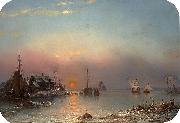 |
Per Wilhelm Cedergren -- Click Here
|
|
painted Winter picture from Dalaro Skans in 1856 |
|
 |
per wickenberg -- Click Here
|
|
1812-1846
Per Gabriel Wickenberg, född 1 oktober 1812 i Malmö, död 19 december 1846 i Pau, var en svensk konstnär.
Per Wickenberg kom från enkla förhållanden, hans far var fanjunkare, men visade tidigt en talang för teckning och måleri. 1831 skedde en insamling till hans förmån i Malmö, mend vars hjälp han fick möjlighet att komma till Stockholm att studera konst. Han besvärades tidigt av en ögonsjukdom, och med hjälp av bidrag från Konstföreningen i Stockholm fick han 1836 hjälp att resa till Tyskland för att söka bot. Efter tillfrisknandet valde han att stanna en tid i Berlin och vann där ett gott erkännande för sina tavlor. 1838 reste han till Paris, och vann där samma år guldmedalj på salongen för sin tavla "Nordiskt vinterlandskap". Wickenberg blev 1839 agre och 1842 ledamot av Konstakademien, under det att han stannade kvar i Paris. Wickenbergs ögonsjukdom återkom dock, och han insjuknade även i tuberkulos. Vintern 1843-44 uppehöll han sig i Nice, för att kurera sig, men förgåves, och 1846 avled han, bara 34 år gammal.
1842 tilldelades han Vasaorden och Hederslegionens kors. |
|
 |
Per Krafft the Elder -- Click Here
|
|
(16 January 1724, Arboga - 7 November 1793, Stockholm) was a Swedish portraitist. He was the father of the artists Per Krafft the Younger and Wilhelmina Krafft.
|
|
|
|
 |
Per Eskilson -- Click Here
|
|
Sweden (1820 -1872 ) - Painter
|
|
|
|
 |
Penleigh boyd -- Click Here
|
|
Australia artist
1890-1923
was an Australian artist. Penleigh Boyd was a member of the Boyd artistic dynasty: his parents Arthur Merric Boyd (1862-1940) and Emma Minnie Boyd (n??e ?? Beckett) were well-known artists of the day, and his brothers included Merric Boyd the ceramacist (1888-1959) and the novelist Martin Boyd (1893-1972). His son Robin Boyd (1919-1971) was a noted writer and architectural critic, and his nephews Arthur Boyd and David Boyd became prominent artists. Born in England at Penleigh House, Westbury, Wiltshire, Boyd received his artistic training from his parents and at the National Gallery Art School. He had his first exhibition at the Victorian Artists' Society at 18, and exhibited at the Royal Academy in London at 21. He won second prize in the Australian Federal Government's competition for a painting of the site of the new national capital, Canberra. He won the Wynne Prize in 1914 with Landscape. He served in the AIF (Australian Infantry Forces) in France in World War I, and was invalided out after being badly gassed at the battle of Ypres in 1917. His career was cut short when he was killed in a car accident near Warragul, Victoria in 1923. Penleigh Boyd is best known as a landscapist with an accomplished handling of evanescent effects of light. A notable influence was artist E. Phillips Fox, who introduced him to plein air techniques when they were neighbours in Paris in 1912-1913. |
|
 |
PENCZ, Georg -- Click Here
|
|
German Northern Renaissance Painter, ca.1500-1550
German painter, draughtsman and engraver. He arrived in Nuremberg in 1523 and entered Albrecht D?rer's workshop. On 12 January 1525 he was imprisoned with the brothers Barthel Beham and Sebald Beham and charged with disseminating the radical views of Thomas M?ntzer (c. 1490-1525) concerning religion and government. The council banished them from Nuremberg, but, after an appeal and intercession by Graf Albrecht von Mansfeld, Pencz was sent to nearby Windsheim, and on 16 November all three were pardoned, though placed under orders regarding their future behaviour. |
|
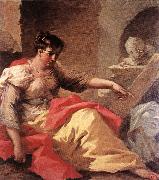 |
PELLEGRINI, Giovanni Antonio -- Click Here
|
|
Italian Rococo Era Painter, 1675-1741
Italian painter. With Sebastiano Ricci and Jacopo Amigoni he was the most important Venetian history painter of the early 18th century. By uniting the High Renaissance style of Paolo Veronese with the Baroque of Pietro da Cortona and Luca Giordano, he created graceful decorations that were particularly successful with the aristocracy of central and northern Europe. He travelled widely, working in Austria, England, the Netherlands, Germany and France. |
|
 |
Pekka Halonen -- Click Here
|
|
Pekka Halonen (23 September 1865 - 1 December 1933) was a painter of Finnish landscapes and people. He was born in Lapinlahti. He lived with his family in a home and studio on Lake Tuusula in Järvenpää, Finland that he, himself, designed and named Halosenniemi. The beautiful and serene building is now a museum that includes original furnishings and Halonenes own art on the walls. There, on the shores of Lake Tuusula where Pekka Halonen resided, an artistse community developed and flourished, helping to develop a sense of Finnish national identity. Halosenniemi was designed with the two story studios of Paris in mind with high ceilings and tall windows in the studio and second floor living quarters accessible by a set of stairs and a balcony that overlooked the studio. Adjacent to the house, Halonen built a sauna and, in typical Finnish tradition, the sauna also served as a laundry. Halonen stated that he never painted for anyone but himself. He felt that eArt should not jar the nerves like sandpaper - it should produce a feeling of peace.e
His father was a peasant from Lapinlahti. Halonen studied at the Art Society's drawing school in Helsinki. In 1890 he moved to Paris where he studied at the Academie Julian and later under Paul Gauguin. He died in Tuusula.
There is a painting by Pekka Halonen in the post-impressionist section of the Museum of Fine Arts in Budapest, Hungary. Until May 2013 in the Groninger Museum, the Netherlands: Pekka Halonen, Eero Järnefeldt, Helene Schjerfbeck and Akseli Gallen Kallela in the exhibition 'Nordic Art: The Modern Breakthrough'. |
|
 |
Pehr Horberg -- Click Here
|
|
was born January 31, 1746 in Virestad parish in Småland, Sweden and died January 24, 1816 in Risinge in Östergötland, Sweden, was a Swedish artist, painter and musician. In 1769 he married the maid Maria Eriksdotter and they had three sons.
Pehr Hörberg birthplace Virestad is a small town and a village in Älmhult Municipality in Kronoberg County, in Småland, Sweden. It was formerly the central area of the old Virestad parish. The church in Virestad was built of stone 1799-1800 on the site of a former medieval church. Some of its treasures include a pulpit from the 1600s and an altarpiece by Pehr Hörberg. He died in Falla in Hällestad Bergslag, where he owned 1/4 of the homestead, and part of the village Olstorp, in Risinge parish, where he also owned 1/4 of the homestead. Both the fourth in Falla in Hällestad and the fourth in Olstorp in Risinge were mining districts estates, located in Finspång Municipality in Östergötland County. Hörberg got his "huts in an aiding position", so to his own satisfaction that he 25 years later wrote about Olstorp and the farm in Falla, that he had later acquired, that the estates were very importat for him. |
|
 |
Pehr Hillestrom -- Click Here
|
|
Swedish, 1732-1816,was a Swedish artist and since 1794 a professor at the Swedish Royal Academy of Art. He became the director in 1810. He produced numerous paintings of mostly women and children performing various daily tasks inside upper- and middle-class homes in Stockholm. Dresses and furniture were painted exactly the way they looked and provide a valuable source of information about what life was like in those days. In addition to this he painted craftsmen in action at mills and other early industrial workplaces. Between 1757 and 1772 he worked as a master tapestry weaver, after learning the trade in France. |
|
 |
pehr hillestrom -- Click Here
|
|
Pehr Hilleström (1732-1816) var en svensk målare och vävare, professor vid Konstakademiens läroverk från 1794 och dess direktör från 1810. I unga år var han en av Sveriges främsta gobelängvävare men övergick sedan till måleri. Han är mest känd för sina vardagsskildringar av sin tids levnadssätt. Han målade pigor och tjänstefolk som arbetar, överklassen i de fina salarna, enkelt folk i stugorna och bilder från olika bruksmiljöer. Genom det räknas han som den största skildraren av den gustavianska samtiden.
Pehr Hilleström är far till konstnären Carl Petter Hilleström och farfars farfars far till Gustaf Hilleström.
Pehr Hilleström föddes i 1732 Väddö, Roslagen, troligtvis den 18 november. Han växte upp under fattiga omständigheter på Väddö prästgård vid sin farbror som var kyrkoherde där. Han var son till en militär och äldst i en syskonskara på 12 barn. Hans far råkade redan 1719 i rysk fångenskap men hade 1723 lyckats återvända till Sverige och då tagit sin tillflykt till brodern på Väddö.
1743 flyttade familjen Hilleström från Roslagen till Stockholm, där Pehr, 10 år gammal, sattes i lära hos tapet- och landskapsmålaren Johan Philip Korn (1727-1796) samt mellan åren 1744-1747 även hos den invandrade tyske solfjädermålaren Christian Fehmer. Utöver detta fick han även undervisning vid kungliga ritareakademin där Guillaume Thomas Taraval (1701-1750) och Jean Eric Rehn (1717-1793) var läromästare.
Efter inrådan från Carl Hårleman sattes Hilleström 1745 i lära hos Jean Louis Duru (-1753). Duru var hautelissevävare och hade kallats till Sverige för att göra textila utsmyckningen av Stockholms slott. Tanken var att Hilleström skulle utbildas till Durus medhjälpare. 1749 visade Hilleström upp ett första läroprov som visades upp för deputationen som gillade det så mycket så att han fick en belöning på 180 daler kopparmynt. När Duru dog i slutet av 1753 så fick Hilleström fullborda den påbörjade kappan för tronhimmelen i det kungliga audiensrummet. Han var då så skicklig att det knappt kunde märkas någon skillnad mellan hans och hans lärares arbete. Lönen var blygsam men vid 1756 års riksdag fick han samma årslön som Duru hade haft, och han fick en beställning på ett vävt porträtt av Hårleman utfört i hautelisse.
Åren 1757-58 var Hilleström på en längre och för tidens konstnärer sedvanlig studieresa till utlandet. Färden gick till Paris, Belgien och Holland, bland annat med en vidareutbildning i gobelängteknikerna som mål. I Paris blir Hilleström erbjuden att studera måleri i François Bouchers atelj??, men störst intryck tog han där av genre- och stillebenmålaren Jean-Baptiste-Sim??on Chardin, som undervisade honom vid franska målarakademien. Väl hemma i Stockholm fortsatte han visserligen att göra tapeter, mattor, stolsöverdrag och dylikt för hovet. Men så småningom fylldes slottet behov av vävnader samtidigt som Hilleström fortsatte studera måleri. |
|
|
|
 |
PEETERS, Clara -- Click Here
|
|
Flemish Baroque Era Painter, 1594-1657
|
|
 |
Peeters, Bonaventure II -- Click Here
|
|
Flemish, 1648-1702
|
|
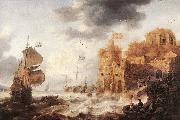 |
PEETERS, Bonaventura the Elder -- Click Here
|
|
Flemish painter (b. 1614, Antwerpen, d. 1652,
Hoboken). |
|
 |
Peeter Danckers de Rij -- Click Here
|
|
Pieter, Peeter, or Peter Danckerts de Rij, Dankers de Ry, or Peteris Dankersas (1605, Amsterdam - 9 August 1661, Rudnik) was a Dutch Golden Age painter.
He was the son of Cornelis Danckerts de Ry, member of a large family of printers, painters and engravers.
Adam Kazanowski - by Peeter Danckers de Rij.
Example of Dankerts-Sandrart collaboration in print of PC Hooft. This 1642 engraving was painted by Sandrart, etched by Reinier van Persijn, and printed by Danckerts. The poem in Latin at the bottom was written by Caspar Barlaeus.Cornelis is mentioned in Houbraken's Schouburg as being one of the many teachers of Joachim von Sandrart in 1640-41, though considering Sandrart's age and experience (he had just returned to the North from his Grand Tour to Italy), this was more of a collaboration. Since Filippo Baldinucci later wrote a biograhical sketch on Pietro Danckerse de Ry in his list of artists called the Notizie, it is possible that Danckerts visited Italy at some time. In any case Sandrart engraved some of Peter's paintings after this period. Peter was active until 1640 in Amsterdam, and then he moved to Warsaw, Danzig, and Vilnius in the Polish-Lithuanian Commonwealth. He was active in Poland as the court painter and architect of the Polish King Władysław IV Vasa. According to Houbraken a poem was written in his honor that applauds his work in Poland. He died as the result of a highway robbery in the Redininkai Forest near Vilnius, Lithuania. |
|
 |
Pedro Weingatner -- Click Here
|
|
Pedro Weingärtner (Porto Alegre, 1853 e 1929) was an important Academic painter of Brazil, and the first artist born in Rio Grande do Sul to win international praise for his work.
Born to a family of German immigrants, he began his artistic career as an amateur, helped by his brother Ineio, who was a lithographer, and possibly also by painter Delfim da Câmara. Anyway, in 1878 he moved to Germany in order to study in the Grossherrzoglisch Badische Kunstschule, in Karlsruhe. There he became a pupil of Ferdinand Keller, Theodor Poeckh and Ernst Hildebrand. In 1880 Keller moved to Berlin, being followed by Weingärtner, who then enrolled in the local Academy.
In 1882 he left Germany for France, studying in the Academie Julian under Tony Robert-Fleury and William Adolphe Bouguereau. Wrecked by financial issues, he thought of abandoning his studies, but such situation was reverted by supportive friends, including Baron of Itajube, who got for him a special scholarship from emperor Peter II upon Bouguereau's advice. Then he could further his education in Rome.
Thereafter for many years he divided his time between Rio de Janeiro, Porto Alegre and Rome, traveling very often and being celebrated as one of the most important Brazilian painters of his generation. In Rio Grande do Sul he was a star. In 1920 he was back in Porto Alegre, where the remained until death. His fame declined from 1925 on, facing competition from new painters and changing tastes in local art.
He devoted all his efforts to a half-Realist half-Romantic approach to Academicism even while such styles were already being severely challenged by Modern tendencies. Major themes in his work were mythological scenes, landscapes and genre paintings focusing mainly immigrants and the gaucho, the folk type of Rio Grande do Sul people.
|
|
 |
Pedro Weingartner -- Click Here
|
|
(Porto Alegre, 1853 - 1929) was an important Academic painter of Brazil, and the first artist born in Rio Grande do Sul to win international praise for his work.
Born to a family of German immigrants, he began his artistic career as an amateur, helped by his brother Inecio, who was a lithographer, and possibly also by painter Delfim da Câmara. Anyway, in 1878 he moved to Germany in order to study in the Grossherrzoglisch Badische Kunstschule, in Karlsruhe. There he became a pupil of Ferdinand Keller, Theodor Poeckh and Ernst Hildebrand. In 1880 Keller moved to Berlin, being followed by Weingärtner, who then enrolled in the local Academy.
In 1882 he left Germany for France, studying in the Academie Julian under Tony Robert-Fleury and William Adolphe Bouguereau. Wrecked by financial issues, he thought of abandoning his studies, but such situation was reverted by supportive friends, including Baron of Itajube, who got for him a special scholarship from emperor Peter II upon Bouguereau's advice. Then he could further his education in Rome.
Thereafter for many years he divided his time between Rio de Janeiro, Porto Alegre and Rome, traveling very often and being celebrated as one of the most important Brazilian painters of his generation. In Rio Grande do Sul he was a star. In 1920 he was back in Porto Alegre, where the remained until death. His fame declined from 1925 on, facing competition from new painters and changing tastes in local art. |
|
 |
Pedro Sanchez -- Click Here
|
|
Spanish Early Renaissance Painter, active ca.1454-1468 |
|
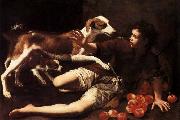 |
Pedro Nunez de Villavicencio -- Click Here
|
|
Spanish Baroque Era Painter, 1640-ca.1695 |
|
 |
Pedro Figari -- Click Here
|
|
(June 29, 1861-July 24, 1938) was a Uruguayan painter, lawyer, writer, and politician. Although he did not begin the practice until his later years, he is best known as an early modernist painter who emphasized capturing the every-day aspects of life in his work. In most of his pieces, he attempts to capture the essence of his home by painting local customs that he had observed in his childhood.
Figari painted primarily from memory, a technique that gives his work a far more personal feeling. With his unique style, which involved painting without the intention to create an illusion, he, along with other prominent Latin-American artists such as Diego Rivera and Tarsila do Amaral, sparked a revolution of identity in the art world of Latin America.
|
|
 |
Pedro Blanes -- Click Here
|
|
1878-1926
Uruguayan painter. He first studied painting and drawing as a child with the Catalan painter Miguel Jaume i Bosch. As an adolescent he moved with his family to Spain, where he studied at the Real Academia de Bellas Artes de San Fernando in Madrid and frequented the workshop of Santiago Rusieol. After studying in Paris with Benjamin Constant, he visited Italy and Mallorca, where he first developed his talents as a landscape painter before returning briefly to Uruguay in 1899. During another prolonged visit to Europe from 1902 to 1907 he enthusiastically studied the work of Pierre Puvis de Chavannes, Lucien Simon, Henri Martin, Claude Monet and James Abbott McNeill Whistler. After his return to Montevideo in 1907 he painted shimmering Impressionist-influenced landscapes such as Palma de Mallorca and treated local rural and urban scenes in which he established himself as a remarkable colourist. He also commemorated subjects from Latin American history in works such as Artigas Dictating to his Secretary Don Jose G. Monterroso , the equestrian portrait of General Galarza and Artigas in el Hervidero. |
|
 |
Pedro Berruguete -- Click Here
|
|
(c. 1450 - 1504) was a Spanish painter; his art is regarded as a transitional style between gothic and Renaissance. Born in Paredes de Nava, Spain, he went to Italy in 1480 and worked in Federigo da Montefeltro's court in Urbino, where he could see some works by Melozzo da Forle. He came back to Spain in 1482 and painted in several cities, such as Sevilla, Toledo and Ávila. He was the father of an important sculptor, Alonso Berruguete, considered the most important sculptor in Renaissance Spain.
|
|
 |
Pedro Americo -- Click Here
|
|
de Figueiredo e Melo (Areia, Brazil, 29 April 1843 - Florence, Italy, 7 October 1905) was one of the most important academic painters of Brazil. He was also a writer and a teacher.
He moved to Rio de Janeiro in 1854, where he was granted a scholarship to study in the Academia Imperial de Belas Artes (Imperial Academy of Fine Arts). Later he furthered his studies in Europe, at the École des Beaux-Arts in Paris, being a pupil of Jean-Auguste-Dominique Ingres, Hippolyte Flandrin and Carle-Horace Vernet, winning much praise for his paintings, and achieving the Doctorate in Sciences at the University of Brussels, in 1868.
Returning to Brazil, he produced a great series of masterpieces, including one of the most well known works of art in Brazil: Independence or Death!, depicting the moment when Prince Peter declared the country independent from Portugal, a work that has illustrated History books for elementary schools in Brazil for decades. Living mostly in Florence, Italy but traveling extensively back and forth from Rio de Janeiro, Pedro Am??rico managed to work also as a lecturer and an art historian.
He married Carlota de Ara??jo Porto-alegre (1844?C1918), daughter of painter and diplomat Manuel de Ara??jo Porto-alegre, and they had children. Knighted by the German Crown he was also Great Knight of the Order of the Holy Sepulchre. With the proclamation of the Republic in Brazil in 1889, he was elected a deputy of the National Assembly.
|
|
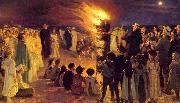 |
Peder Severin Kroyer -- Click Here
|
|
Norwegian-born Danish Painter, 1851-1909
Norwegian-Danish painter, was born in Stavanger, Norway to Ellen Cecilie Gjesdal. He is one of the best known and beloved, and undeniably the most colorful of the Skagen Painters, a community of Danish and Nordic artists who lived, gathered or worked in Skagen, Denmark, especially during the final decades of the 1800s. Krøyer was the unofficial leader of the group. The mother having been judged unfit, he was given to be cared for by Gjesdal's sister and the sister's husband. Along with the foster parents, he moved to Copenhagen soon afterwards. He began his art education at nine years of age under private tutelage, and was enrolled in Copenhagen's Technical Institute the following year. In 1870 at the age of 19 he completed his studies at the Royal Danish Academy of Art (Det Kongelige Danske Kunstakademi), where he studied with Frederik Vermehren. In 1873 he was awarded the gold medal and a scholarship. His official debut as a painter was in 1871 at Charlottenborg with a portrait of a friend, painter Frans Schwartz. He exhibited regularly at Charlottenborg throughout his lifetime. In 1874 Heinrich Hirschsprung bought his first painting from Krøyer, |
|
 |
Peder Severin Kroyer -- Click Here
|
|
(23 July 1851 - 21 November 1909), known as P.S. Krøyer, was a Norwegian-Danish painter. He is one of the best known and beloved, and undeniably the most colorful of the Skagen Painters, a community of Danish and Nordic artists who lived, gathered or worked in Skagen, Denmark, especially during the final decades of the 19th century. Krøyer was the unofficial leader of the group.
|
|
|
|
 |
Peder Balke -- Click Here
|
|
Peter Andersen was born on the island of Helgøya, in Hedmark county, Norway. He grew up Ringsaker, but stayed in the 1820s on the Balke farm in Toten in Oppland county. Farmers in Toten paid his education, and as thanks he decorated several of the farms in Toten on his return. They actively encouraged his painting activities and later supported him in higher education.
In the autumn of 1827, Balke served as an apprentice to Heinrich August Grosch. he was also a student at the Tegneskole under Grosch and Jacob Munch. Balke signed a two year contract as an apprentice at the Danish decoration and artist Jens Funch. From autumn 1829 to spring 1833, he was a pupil of Carl Johan Fahlcrantz at the art academy in Stockholm. Balke was also a pupil of Johan Christian Dahl from 1843 to 1844.
During the summer of 1830 he walked through Telemark, Rjukan, Vestfjorddalen over Røldal and Kinsarvik to Bergen, and then back over Vossevangen to Gudvangen, further over Fillefjell to Valdres and thence across the mountains to Hallingdal. All the way he painted and drew small sketches that were later developed into paintings. He also traveled to Germany, and Russia. He visited Paris and London.
In Stockholm, he completed several of the paintings he had outlined of his Finnmark tour. Some of these were sold to the royal family. In 1846 he sold thirty of his paintings to Louis-Philippe of France for Versailles. Besides the 17 paintings in the National Gallery in Oslo, Peder Balke also is represented at several major art collections in Norway and Sweden.
|
|
 |
Peder Als -- Click Here
|
|
Peder Als, a Danish historical and portrait painter, born at Copenhagen in 1725, studied for some time under C. G. Pile. After gaining the first great prize given by the academy at Copenhagen in 1755, he went to Rome and entered the school of Mengs. He occupied himself chiefly in copying the pictures of Raphael and Andrea del Sarto, which it is said that he did with great accuracy. He also copied Correggio and Titian. On his return to his own country he painted some good portraits; but his colouring was too sombre to give a pleasing effect to his pictures of females, and his work was frequently so laboured as to be deprived of all animation. Copies of the works of the old masters by Als are to be seen in Denmark. He died in 1775. |
|
 |
Peck Sheldon -- Click Here
|
|
American portrait painter and artist
b.1797 d.1868
American painter. A self-taught painter, he used his family as subjects in his early works, employing dark colours against flat backgrounds. After moving to Jordan, NY, in 1828 he used brighter colours and included more detail. He continued to paint on panel, almost always making half-length portraits characterized by such features as a broad brow, a wide, intense stare from detailed eyes and the use of a decorative brushstroke |
|
 |
Pearce, Charles Sprague -- Click Here
|
|
American, 1851-1914
American artist, was born at Boston, Massachusetts. In 1873 Pearce became a pupil of L??on Bonnat in Paris, and after 1885 he lived in Paris and at Auvers-sur-Oise. He painted Egyptian and Algerian scenes, French peasants, and portraits, and also decorative work, notably for the Thomas Jefferson Building at the Library of Congress at Washington. He received medals at the Paris Salon and elsewhere, and was made Chevalier of the French Legion of Honor, decorated with the Order of Leopold, Belgium, the Order of the Red Eagle, Prussia, and the Order of the Dannebrog, Denmark. Among his best known paintings are The Decapitation of St John the Baptist (1881), in the Art Institute of Chicago; Prayer (1884), |
|
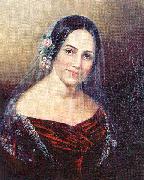 |
Peale, Sarah Miriam -- Click Here
|
|
American Painter, 1800-1885
Painter, daughter of James Peale. The most notable of James Peale's painting daughters, she also studied with her uncle Charles Willson Peale and her cousin Rembrandt Peale, from whom she developed her talent for colour and precision in details. As studio assistant to her father, she occasionally introduced into his work bright and intricate fabrics. Her career began in 1817 with the exhibition of Flowers at the Pennsylvania Academy of the Fine Arts. In the 1820s she painted in Baltimore and Philadelphia; in 1824 she was elected to the Pennsylvania Academy. From 1831 to 1846 she maintained her studio in Baltimore where she was a popular portrait painter, producing unpretentious but intelligent and occasionally romantic portraits characterized by a fine concern for materials, as in Mrs Perry Eccleston Noel (c. 1822; Baltimore, Mus. & Lib. MD Hist.). Her sitters included such prominent politicians as Daniel Webster (1842; St Louis, MO Hist. Soc. Mus.) and Abel Park Upshur (1842; Baltimore, Mus. & Lib. MD Hist.). In 1847 Sarah moved to St Louis, MO, where for 32 years she was in great demand. From 1859 her still-lifes won prizes at the St Louis fairs; they were loosely painted works different from the tightly controlled table-top pieces of her father and sister. Sarah's portraiture also changed, from the elegant, precise Neo-classicism learnt from her cousin Rembrandt to a looser, |
|
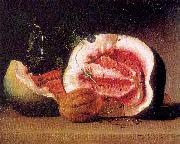 |
Peale, Raphaelle -- Click Here
|
|
American Painter, 1774-1825
Painter, son of Charles Willson Peale. His mother was Rachel Brewer Peale. He studied painting with his father and assisted him in the museum. Raphaelle began to paint portraits professionally in 1794, but poor patronage in Philadelphia forced him to travel in the South and New England, taking silhouettes with the physiognotrace and painting portraits in oil and miniature. From about 1815 onwards, bouts of alcoholism and gout inhibited his progress. He turned to painting still-lifes, but these sold for small amounts. |
|
 |
Peale, James -- Click Here
|
|
American, 1749-1831
Painter, brother of Charles Willson Peale. Charles encouraged him to become a painter; James also worked as a frame-maker for his brother until the Revolution, in which he served as a lieutenant. From 1779 James shared Charles's practice, specializing in miniatures. His early work, occasionally confused with Charles's, shows his brother's influence. After 1794, his style became clearly his own: more delicate with subtle colour harmonies, softened outlines and free handling; it may be distinguished by a faint violet tone in the shadows and the inconspicuous signature 'IP'. His miniatures of male subjects are frequently superior to his portraits of women, for example Benjamin Harwood (1799; Baltimore, Mus. & Lib. MD Hist.), but his meticulous attention to costume and his success in imparting colour and sparkle to skin and eyes, |
|
 |
Peale, Harriet Cany -- Click Here
|
|
American, 1800-69 |
|
|
|
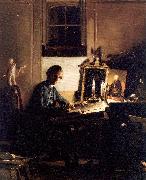 |
Paye, Richard Morton -- Click Here
|
|
English, 1750-1821 |
|
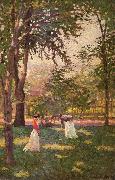 |
Paxton, William McGregor -- Click Here
|
|
American Painter, 1869-1941
was an American Impressionist painter. Born in Baltimore, the Paxton family came to Newton Corner in the mid-1870s, where William's father James established himself as a caterer. At 18, William won a scholarship to attend the Cowles Art School, where he began his art studies with Dennis Miller Bunker. Later he studied with Jean-L??on G??rôme in Paris and, on his return to Boston, with Joseph DeCamp at Cowles. There he met his future wife Elizabeth Okie, who also was studying with DeCamp. After their marriage, William and Elizabeth lived with his parents at 43 Elmwood Street, and later bought a house at 19 Montvale Road in Newton Centre. Paxton, who is best known as a portrait painter, taught at the Museum School from 1906 to 1913. Along with other well known artists of the era, including Edmund Charles Tarbell and Frank Benson, he is identified with the Boston School. Like many of his Boston colleagues, Paxton found inspiration in the work of the seventeenth-century Dutch painter Johannes Vermeer. Paxton was fascinated not only with Vermeer's imagery, but also with the system of optics he employed. He studied Vermeer's works closely, and discovered that only one area in his compositions was entirely in focus, while the rest were somewhat blurred. Paxton ascribed this peculiarity to "binocular vision," crediting Vermeer with recording the slightly different point of view of each individual eye that combine in human sight. He began to employ this system in his own work, including The New Necklace, where only the gold beads are sharply defined while the rest of the objects in the composition have softer, blurrier edges. |
|
 |
Pawel Andrejewitsch Fedotow -- Click Here
|
|
painted Junge Witwe in 1851 |
|
 |
Pavel Filonov -- Click Here
|
|
1883-1941
Pavel Filonov Locations
Russian painter, graphic artist and poet. He came from a working-class background; orphaned in childhood, he moved to St Petersburg, where he earned money through embroidery, house painting, restoring buildings and icons, and other tasks such as retouching photographs and making posters and wrappers for goods (a practical apprenticeship he never forgot). His interest in drawing and painting developed through copying, making portraits and the close study of human and animal anatomy. He entered the Academy of Arts, St Petersburg (1908) with difficulty but he left without graduating; his only important teacher was L. E. Dmitriyev-Kavkazsky (1849-1916), with whom he studied privately. Largely self-taught, he was a man of considerable intellectual powers. |
|
 |
Pavel Fedotov -- Click Here
|
|
1815-1852 Realism Russian Russian painter and draughtsman. He was noted for his satirical critique of Russian life of the mid-19th century. He attended the First Moscow Military School (1826-33), then served in St Petersburg in the Finnish Regiment Life-Guards. While earning a reputation as an honest and hard-working officer, he drew a great deal, played the flute and took part in amateur theatrical performances. Having become established as the regimental artist, in 1834 he began to attend evening classes at the St Petersburg Academy of Arts. In November 1843, after a long period of doubt, he resigned his commission in the army in order to become a professional artist. He began to attend the Academy regularly and joined the battle-painting class of Aleksander Zauerveid (1783-1844), |
|
 |
Pavel Chistyakov -- Click Here
|
|
(July 5 [O.S. June 23] 1832 - November 11, 1919) was a Russian painter and teacher of art.
He studied at the St.Petersburg Academy of arts (1849-1861) under Petr Basin. He was a pensioner of the Academy of Arts in Paris and in Rome (1862?C1870). He taught in the Drawing School of the Society for the Encouragement of the Arts (1860-1864), and in St.Petersburg (from 1872) he was the professor-head of workshop (1908-1910) and managing mosaic branch (1890-1912). The art-pedagogical system of Chistiakov, whose students included Viktor Vasnetsov, Mikhail Vrubel, Vasily Polenov, Ilya Repin, Valentin Serov, and Vasily Surikov, developed in constant struggle against the inert system of academism and played a huge role in the development of realism in Russian art of the second half of the 19th century.
The main goal of Chistiakov was the preparation of the artist-citizen possessing high professional skill. His pedagogical method assumed the merger of the direct perception of nature by the artist with its scientific study. In creative practice he aspired to dramatization of a historical plot and psychological saturation in historical and genre portraits (Head of a Ciucciara, 1864, in the Russian Museum, |
|
 |
Pauwels van Hillegaert -- Click Here
|
|
(1596-1640) was a Dutch Golden Age painter of landscapes and military scenes.
He married Anneken Homis from Antwerp in 1620, with whom he had several children, including the painter with the same name, Pauwels van Hillegaert II (1621-1658). This Pauwels Jr. married Cornelia de Vlieger (daughter of Simon de Vlieger) and had two daughters. When Pauwels Jr. like his father died at a relatively young age, Cornelis de Bie wrote a commemorative poem about him.
Pauwels Sr. won royal commissions to paint battle scenes, most notably for the Siege of 's-Hertogenbosch in 1629. He also won a commission for the Battle of Nieuwpoort. He also painted Italianate landscapes, but was mostly admired for his horses and armor.
|
|
 |
Paulus Moreelse -- Click Here
|
|
(1571, Utrecht - 6 March 1638, Utrecht) was a Dutch painter, mainly of portraits.
Moreelse was a pupil of the Delft portrait painter Michiel Jansz. van Mierevelt, who had himself been a pupil of Anthonie van Blocklandt. He took a study-trip to Italy, where he received many portrait commissions. Back in Utrecht, in 1596 he became a member of the zadelaarsgilde, which was the traditional name in Utrecht for the Guild of Saint Luke. In 1611, along with Abraham Bloemaert, he was one of the founders of a new painters' guild, called "St. Lucas-gilde", and became its first deken.
Moreelse was a well known portrait painter who received commissions from right across the Dutch Republic. His earliest work dates to 1606. Other than portraits, he also painted a few history paintings in the Mannerist style and in the 1620s produced pastoral scenes of herders and shepherds. He belonged to the same generation as Abraham Bloemaert and Joachim Wtewael, and like Wtewael he played an important role in the public life of their city. His version of Diana and Callisto was engraved by Jan Saenredam. In 1618, when the anti-remonstrants came to power in Utrecht, he was raadslid.
|
|
 |
Paulus Bor -- Click Here
|
|
(Amersfoort, c. 1601 - Amersfoort, 10 August 1669) was a Dutch painter.
Bor was descended from a notable Catholic family. He made a study trip to Rome, where he was one of the founders of the Bentvueghels, taking the nickname Orlando. He returned in 1626 to Amersfoort and joined Jacob van Campen in the decoration of the palace Honselaarsdijk belonging to Frederik Hendrik. In 1656, he became regent of the godshuis "De Armen de Poth" in Amersfoort.
Bor's style of painting was rather at odds with that of contemporary painters from Utrecht. He initially painted rather Caravaggisti-like history paintings, but his works fast became marked by a classicism related to that of his townsman van Campen. Through unusual compositions and primitive technique, his paintings depict strange and mysterious subjects.
|
|
 |
Paula Modersohn-Becker -- Click Here
|
|
German
1876-1907
Paula Becker was born and grew up in Dresden-Friedrichstadt. She was the third child of seven children in her family. Her father who was the son of a Russian university professor, was employed with the German railway. He and Modersohn-Becker's mother, who was from an aristocratic family, provided the children a cultured and intellectual environment in the house hold.
Modersohn-Becker's parental home 1888-1899In 1888 her parents moved from Dresden to Bremen. While visiting an aunt in London, England, she received her first instruction in drawing. Apart from her teacher's training in Bremen in 1893-1895, Paula took private instruction in painting. In 1896 she participated in a course for painting and drawing sponsored by the "Verein der Berliner K??nstlerinnen" (Union of Berlin Female Artists) which offered art studies to women.
Paula Modersohn-Becker. Clara Rilke WesthoffAt the age of 22, she encountered the artistic community of Worpswede. In this "village", artists such as Fritz Mackensen (1866-1953) and Heinrich Vogeler (1872-1942) had retreated to protest against the domination of the art academy and life in the big city. At Worpswede, Paula Modersohn-Becker took painting lessons from Mackensen. The main subjects were the life of the farmers and the northern German landscape. At this time she began close friendships with the sculptor Clara Westhoff (1875-1954) and the poet Rainer Maria Rilke (1875-1926). She also fell in love during this period, and in 1901 she married a fellow Worpswede painter, Otto Modersohn. In marrying Otto, she also became a stepmother to Otto's daughter, Elsbeth Modersohn, the child from his first marriage to Helene Modersohn, then deceased.
Paula Modersohn-Becker. Rainer Maria Rilke, 1906Between 1900 and 1907, Paula made several extended trips to Paris for artistic purposes, sometimes living separately from her husband, Otto. During one of her residencies in Paris, she took courses at the Ecole des Beaux-Arts. She visited contemporary exhibitions often, and was particularly intrigued with the work of Paul C??zanne. Other post impressionists were especially influential, including Vincent Van Gogh and Paul Gauguin. Fauve influences may also appear in such works as Poorhouse Woman with a Glass Bottle. The influence by the work of French painter, Jean-Francois Millet, who was widely admired among the artists in the Worpswede group, may be seen in such pieces as her 1900 Peat Cutters.
Reclining Mother and ChildIn her last trip to Paris in 1906, she produced a body of paintings from which she felt very great excitement and satisfaction. During this period of painting, she produced her initial nude self-portraits (something surely unprecedented by a female painter) and portraits of friends such as Rainer Maria Rilke and Werner Sombart. Some critics consider this period of her art production to be the strongest and most compelling.
Paula with Mathilde, November 1907 (days before Paula's death)In 1907, Paula Modersohn-Becker returned to her husband in Worpswede. Their relationship, which had been particularly strained in 1906, had taken a turn towards improvement. Paula's long-lived wish to conceive and bear a child was fulfilled. Her daughter Mathilde (Tillie) Modersohn was born on November 2, 1907. Paula and Otto were joyous. Sadly, the joy became soon overshadowed by tragedy, as Paula Modersohn-Becker died suddenly in Worpswede on November 20th from an embolism.
In 1908, Rainer Maria Rilke wrote the renowned poem, "Requiem for a Friend", in Paula's memory. The poem was born of the imprint that Paula's life, death and friendship left upon Rilke. |
|
 |
Paul-Louis Bouchard -- Click Here
|
|
French, 1853-1937 |
|
 |
Paul-Camille Guigou -- Click Here
|
|
1834-1871
French
Paul Camille Guigou Gallery
French painter. Born into a family of landowners, he became a notary's clerk at Apt in 1851 and then in 1854 at Marseille. He learnt to paint with Camp, a teacher at the school in Apt, and then at Marseille with Emile Loubon (1809-63), director of the local Ecole des Beaux-Arts, who urged him (according to Guigou's biographers) to paint directly from nature. Guigou settled in Marseille in 1854, where he participated regularly in the annual Salon of the Societe Artistique des Bouches-du-Rhene. Guigou painted almost exclusively Proven?al landscapes, which were influenced by the works of the Barbizon painters, who exhibited in Marseille, and by the brownish tones and picturesque figures of Loubon's paintings. The Road to Gineste (1859) and The Washerwoman (1860; both Paris, Mus. d'Orsay) reflect the independent tradition of Proveneal painting during the Second Empire, which was characterized by warm colouring and precise lighting used to separate and distinguish forms. His knowledge of the works of Gustave Courbet, acquired during a visit to Paris in 1859, doubtless increased his liking for broad technique and sincere vision, articulated in a strong and ordered construction of space: for example, The Gorges of the Luberon (c. 1861; Amiens, Mus. Picardie). |
|
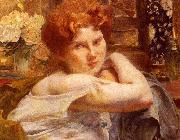 |
Paul-Albert Besnard -- Click Here
|
|
(2 June 1849 --4 December 1934) was a French painter and printmaker.
He was born in Paris and studied at the École des Beaux-Arts, studied with Jean Bremond and was influenced by Alexandre Cabanel. He won the Prix de Rome in 1874 with the painting Death of Timophanes
Until about 1880 he followed the academic tradition, but then broke away completely, and devoted himself to the study of colour and light as conceived by the Impressionists. The realism of this group never appealed to his bold imagination, but he applied their technical method to ideological and decorative works on a large scale, such as his frescoes at the Sorbonne, the Ecole de Pharmacie, the ceiling of the Comedie-Française (main theatre in Paris), the Salle des Sciences at the Hôtel de Ville, the mairie of the Ier arrondissement, and the chapel of Berck hospital, for which he painted twelve Stations of the Cross in an entirely modern spirit.
A great virtuoso, he achieved brilliant successes alike in watercolour, pastel, oil and etching, both in portraiture, in landscape and in decoration. His close analysis of light can be studied in his picture La femme qui se chauffe at the Luxembourg in Paris, one of a large group of nude studies of which a later example is Une Nymphe au bord de la mer; and in the work produced during and after a visit to India in 1911. A large panel, Peace by Arbitration, was completed seven days before the outbreak of war in 1914. |
|
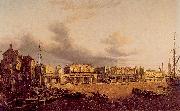 |
Paul, John -- Click Here
|
|
English, active 1858-1886 |
|
 |
Paul von Franken -- Click Here
|
|
(1818- 1884 ) - Painter
painted Paul von Franken. View of Tiflis in 1866
|
|
 |
Paul Troger -- Click Here
|
|
Austrian Painter, 1698-1762
was an Austrian painter, draughtsman and printmaker of the late Baroque period. Troger's illusionistic ceiling paintings in fresco are notable for their dramatic vitality of movement and their palette of light colors. Paul Troger??s style, particularly in his frescoes, dominated Austrian painting until the end of the 18th century and profoundly influenced significant artists of the next generation, notably Franz Anton Maulbertsch, Josef Ignaz Mildorfer, Johann Wenzel Bergl. Paul Troger was born on October 30, 1698, in Welsberg, in the Puster Valley of Tyrol (now Bolzano-Bozen, Italy). At the age of 16, under the patronage of the aristocratic Tyrolean von Firmian family, he visited Fiume and became a pupil of Giuseppe Alberti.[2] He painted his first fresco ??Three Angels with the Cross and Putti??, in the Chiesa del Calvario, Kaltern am See/Caldaro al Lago, Bolzano, Italy (1722). In 1722, the prince-bishop of Gurk sent Paul Troger to Venice, where he discovered the works of Giovanni Battista Piazzetta, and Giovanni Battista Pittoni. Troger also studied in Rome with Sebastiano Ricci, in Naples with Francesco Solimena and in Bologna, the leading artistic centers of Italy at the time. On his return to Austria, Troger first worked in Salzburg from 1726 to 1728, where he painted the "Glory of Saint Cajetan" on the ceiling of St. Cajetan??s Church, Salzburg (1728). He afterwards established himself in Vienna, where the art of ceiling frescoes was, however, dominated by Johann Michael Rottmayr and Daniel Gran. Paul Troger became the favourite fresco painter in Lower Austrian monasteries in collaboration with the architect Josef Munggenast. In 1753, he joined the Imperial Academy of Fine Arts. |
|
 |
Paul Signac -- Click Here
|
|
1863-1935
French
Paul Signac Galleries
Paul Victor Jules Signac was born in Paris on November 11, 1863. He followed a course of training in architecture before deciding at the age of 18 to pursue a career as a painter. He sailed around the coasts of Europe, painting the landscapes he encountered. He also painted scenes of cities in France in his later years.
In 1884 he met Claude Monet and Georges Seurat. He was struck by the systematic working methods of Seurat and by his theory of colours and became Seurat's faithful supporter. Under his influence he abandoned the short brushstrokes of impressionism to experiment with scientifically juxtaposed small dots of pure colour, intended to combine and blend not on the canvas but in the viewer's eye, the defining feature of pointillism.
Many of Signac's paintings are of the French coast. He left the capital each summer, to stay in the south of France in the village of Collioure or at St. Tropez, where he bought a house and invited his friends. In March 1889, he visited Vincent van Gogh at Arles. The next year he made a short trip to Italy, seeing Genoa, Florence, and Naples.
The Port of Saint-Tropez, oil on canvas, 1901Signac loved sailing and began to travel in 1892, sailing a small boat to almost all the ports of France, to Holland, and around the Mediterranean as far as Constantinople, basing his boat at St. Tropez, which he "discovered". From his various ports of call, Signac brought back vibrant, colourful watercolors, sketched rapidly from nature. From these sketches, he painted large studio canvases that are carefully worked out in small, mosaic-like squares of color, quite different from the tiny, variegated dots previously used by Seurat.
Signac himself experimented with various media. As well as oil paintings and watercolours he made etchings, lithographs, and many pen-and-ink sketches composed of small, laborious dots. The neo-impressionists influenced the next generation: Signac inspired Henri Matisse and Andr?? Derain in particular, thus playing a decisive role in the evolution of Fauvism.
As president of the Societe des Artistes Ind??pendants from 1908 until his death, Signac encouraged younger artists (he was the first to buy a painting by Matisse) by exhibiting the controversial works of the Fauves and the Cubists. |
|
 |
Paul Serusier -- Click Here
|
|
French Painter, 1863-1927
was a French painter who was a pioneer of abstract art and an inspiration for the avant-garde Nabi movement. He studied at the Academie Julian and was a monitor there in the mid 1880s. In the summer of 1888 he travelled to Pont-Aven and joined the small group of artists centered there around Paul Gauguin. While at the Pont-Aven artist's colony he painted a picture that became known as The Talisman, under the close supervision of Gauguin. The picture was an extreme exercise in Cloisonnism that approximated to pure abstraction. He was a Post-Impressionist painter, a part of the group of painters called Les Nabis. Serusier along with Paul Gauguin named the group. Pierre Bonnard, Edouard Vuillard and Maurice Denis became the best known of the group, but at the time they were somewhat peripheral to the core group. |
|
 |
Paul Serusie -- Click Here
|
|
French Painter, 1863-1927 |
|
 |
Paul Sandby Munn -- Click Here
|
|
British watercolour painter, 1773-1845 |
|
 |
Paul Revere -- Click Here
|
|
American Sculptor and Engraver, 1735-1818
was an American silversmith and a patriot in the American Revolution. Because he was glorified after his death for his role as a messenger in the battles of Lexington and Concord, Revere's name and his "midnight ride" are well-known in the United States as a patriotic symbol. In his lifetime, Revere was a prosperous and prominent Boston craftsman, who helped organize an intelligence and alarm system to keep watch on the British military. Revere later served as an officer in one of the most disastrous campaigns of the American Revolutionary War, a role for which he was later exonerated. After the war, he was early to recognize the potential for large-scale manufacturing of metal. |
|
 |
Paul Raud -- Click Here
|
|
(22 October 1865 in Kirikukela, Viru-Jaagupi Parish C 22 November 1930 in Tallinn) was an Estonian painter. The twin brother of painter Kristjan Raud, he studied in Desseldorf beginning in 1886, becoming influenced by the work of Eduard Gebhardt. After his return to Estonia, he painted mainly portrait commissions for some time, before traveling with his brother and Amandus Adamson to the islands of Muhu and Pakri in 1896. His works of this period are reminiscent of those of Max Liebermann. In 1899 he returned to work in Germany, taking on some of the stylistic trappings of Impressionism; this, coupled with time spent working with Ilya Repin, influenced his later style. Later in his career, most especially during and after World War I, he began to teach, from 1915 working as a drawing instructor at the Tallinn Institute of Commerce and from 1923 at the State School of Industrial Art in Tallinn.
|
|
 |
Paul Ranson -- Click Here
|
|
French Nabi Painter, 1864-1909
French painter and designer. The son of a successful local politician, Ranson was encouraged from the outset in his artistic ambitions. He studied at the Ecoles des Arts D?coratifs in Limoges and Paris but transferred in 1886 to the Acad?mie Julian. There he met Paul S?rusier and in 1888 became one of the original members of the group known as the NABIS. From 1890 onwards, Ranson and his wife France hosted Saturday afternoon meetings of the Nabis in their apartment in the Boulevard du Montparnasse, jokingly referred to as 'Le Temple'. Ranson acted as linchpin for the sometimes dispersed group. Noted for his enthusiasm and wit and for his keen interests in philosophy, theosophy and theatre, he brought an element of esoteric ritual to their activities. For example he introduced the secret Nabi language and the nicknames used familiarly within the group. |
|
 |
Paul Philippoteaux -- Click Here
|
|
artist, born in Paris, France, 27 January, 1846
was a French artist. He is best known for a cyclorama of the Battle of Gettysburg.Paul Philippoteaux was born in Paris, the son of the French artist Henri Emmanuel Felix Philippoteaux. His education was at the Coll??ge Henri-IV, the École des Beaux-Arts in Paris, and in the studio of his father, as well as the studios of Leon Cogniet, and Alexander Cabanal. He became interested in cycloramas and in collaboration with his father created The Defence of the Fort d'Issy in 1871. Other works included Taking of Plevna (Turko-Russian War), the Passage of the Balkans, The Belgian Revolution of 1830, Attack in the Park, The Battle of Kars, The Battle of Tel-el-Kebir, and the Derniere Sortie.He was commissioned by a group of Chicago investors in 1879 to create the Gettysburg cyclorama. He spent several weeks in April 1882 at the site of the Gettysburg Battlefield to sketch and photograph the scene, and extensively researched the battle and its events over several months. Local photographer William H. Tipton created a series of panoramic photographs shot from a wooden tower erected along present-day Hancock Avenue. The photos, pasted together, formed the basis of the composition. Philippoteaux also interviewed several survivors of the battle, including Union generals Winfield S. Hancock, Abner Doubleday, Oliver O. Howard, and Alexander S. Webb, and based his work partly on their recollections.Philippoteaux enlisted a team of five assistants, |
|
 |
Paul Peel -- Click Here
|
|
(7 November 1860 - 3 October 1892) was a Canadian academic painter. Having won a medal at the 1890 Paris Salon, he became one of the first Canadian artists to receive international recognition in his lifetime.
Peel was born in London, Ontario, and received his art training from his father from a young age. Later he studied under William Lees Judson and at the Pennsylvania Academy of the Fine Arts under Thomas Eakins. He later moved to Paris, France where he received art instruction at the Ecole des Beaux-Arts under Jean-Leon Gerôme and at the Academie Julian under Benjamin Constant, Henri Doucet and Jules Lefebvre.
In 1882 he married Isaure Verdier and had two children with her: a son (Robert Andre, in 1886) and a daughter (Emilie Marguerite, in 1888).
Peel travelled widely in Canada and in Europe, exhibiting as a member of the Ontario Society of Artists and the Royal Canadian Academy. He also exhibited at international shows like the Paris Salon, where he won a bronze medal in 1890 for his painting After the Bath. He was known for his often sentimental nudes and for his pictures of children. |
|
 |
Paul Maitland -- Click Here
|
|
British Painter, 1863-1909 |
|
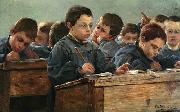 |
Paul Louis Martin des Amoignes -- Click Here
|
|
(1850- 1912 ) - Painter
painted In the classroom. Signed and dated P.L. Martin des Amoignes 1886 |
|
 |
Paul Klee -- Click Here
|
|
German
1879-1940
Paul Klee Gallery
was a Swiss painter of German nationality. His highly individual style was influenced by many different art trends, including expressionism, cubism, and surrealism. He was a student of orientalism. Klee was a natural draftsman who experimented with and eventually mastered color theory, and wrote extensively about it. His works reflect his dry humor and his sometimes child-like perspective, his personal moods and beliefs, and his musicality. He and his friend, the Russian painter Wassily Kandinsky, were also famous for teaching at the Bauhaus school of art and architecture. |
|
 |
Paul Kane -- Click Here
|
|
(September 3, 1810 - February 20, 1871) was an Irish-born Canadian painter, famous for his paintings of First Nations peoples in the Canadian West and other Native Americans in the Oregon Country.
A largely self-educated artist, Kane grew up in Toronto (then known as York) and trained himself by copying European masters on a study trip through Europe. He undertook two voyages through the wild Canadian northwest in 1845 and from 1846 to 1848. The first trip took him from Toronto to Sault Ste. Marie and back. Having secured the support of the Hudson's Bay Company, he set out on a second, much longer voyage from Toronto across the Rocky Mountains to Fort Vancouver and Fort Victoria in the Columbia District, as the Canadians called the Oregon Country. |
|
|
|
|
|
 |
Paul Gauguin -- Click Here
|
|
French
1848-1903
Paul Gauguin Art Locations
(born June 7, 1848, Paris, France ?? died May 8, 1903, Atuona, Hiva Oa, Marquesas Islands, French Polynesia) French painter, sculptor, and printmaker. He spent his childhood in Lima (his mother was a Peruvian Creole). From c. 1872 to 1883 he was a successful stockbroker in Paris. He met Camille Pissarro about 1875, and he exhibited several times with the Impressionists. Disillusioned with bourgeois materialism, in 1886 he moved to Pont-Aven, Brittany, where he became the central figure of a group of artists known as the Pont-Aven school. Gauguin coined the term Synthetism to describe his style during this period, referring to the synthesis of his paintings formal elements with the idea or emotion they conveyed. Late in October 1888 Gauguin traveled to Arles, in the south of France, to stay with Vincent van Gogh. The style of the two men work from this period has been classified as Post-Impressionist because it shows an individual, personal development of Impressionism use of colour, brushstroke, and nontraditional subject matter. Increasingly focused on rejecting the materialism of contemporary culture in favour of a more spiritual, unfettered lifestyle, in 1891 he moved to Tahiti. His works became open protests against materialism. He was an influential innovator; Fauvism owed much to his use of colour, and he inspired Pablo Picasso and the development of Cubism.
|
|
 |
Paul Frenzeny -- Click Here
|
|
French artist , ca.1840-1902
|
|
|
|
|
| | |
|
|
|
|